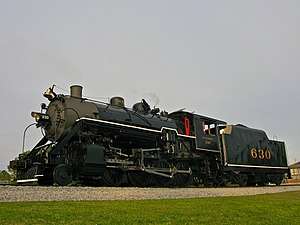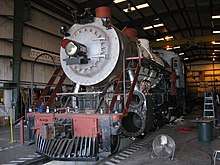Southern Railway 630
Southern Railway 630 is a class "Ks-1" 2-8-0 "Consolidation" type steam locomotive built in February 1904 by the Richmond Works of the American Locomotive Company (ALCO) for the Southern Railway as a member of the Ks-1 "Consolidation" class. It is currently owned and operated by the Tennessee Valley Railroad Museum (TVRM) in Chattanooga, Tennessee where it resides today for use on excursion trains.
| Southern Railway 630 | |||||||||||||||||||||||||
|---|---|---|---|---|---|---|---|---|---|---|---|---|---|---|---|---|---|---|---|---|---|---|---|---|---|
 SOU No. 630 at the Tennessee Valley Railroad Museum's Grand Junction Station in 2011 | |||||||||||||||||||||||||
| |||||||||||||||||||||||||
| |||||||||||||||||||||||||
| |||||||||||||||||||||||||
| |||||||||||||||||||||||||
History
Design and upgrades
Originally as one of thirty-two "K" class locomotives built by the Richmond Works of the American Locomotive Company (ALCO), No. 630 was standardized with 56 in (1.422 m) wheels and rated at 44,100 lb (20,000 kg) of tractive effort.[1] When constructed new in 1904, No. 630 was originally equipped with Stephenson valve gear, sliding valves, and a saturated boiler.[1] In 1911, the locomotive was later upgraded with Southern valve gear, piston valves, and the boiler was equipped with superheaters.[1] With these new upgrades added, No. 630 was reclassified as a "Ks" locomotive.[2] It had more upgrades added such as new cylinders and valve assemblies, which allow the locomotive to develop 46,700 lb (21,200 kg) of tractive effort and reclassified again as a "Ks-1" type.[2]
Revenue service
No. 630 was first put into local and branch line service in Knoxville, Tennessee by Southern Railway before it was moved to Asheville, North Carolina to run on the Murphy and Lake Toxaway branch lines until it was retired from revenue freight service in August 1952.[3][4][5]
Following retirement by Southern, No. 630 and classmate No. 722 were both sold to the East Tennessee and Western North Carolina Railroad (ET&WNC) in November 1952 and renumbered as No. 207 and No. 208, respectively.[3][6][7] Originally, the ET&WNC offered Ks-1s No. 685 (Baldwin, 1904) and No. 835 (Baldwin, 1906), but chose the formers instead due to the latters being stored outside in very poor condition.[5][7]
After ET&WNC's purchasement, Southern cut down the size of the two Ks-1 locomotives' tender coal bunker to make sure that it would be easier for the engineer to get a better view during numerous switching moves and reverse operation.[7]
1968–1989 excursion service
In late 1967, No. 207 (No. 630) and No. 208 (No. 722) were both traded back to the Southern Railway for use in their steam excursion program in return for a pair of former Central of Georgia ALCO RS-3s.[8] Receiving their old numbers again, No. 630 had been given minor repairs and began excursion service in February 1968, while No. 722 had its firebox repaired and returned to operating service in August 1970.[9][10][11]
No. 630 and No. 722 pulled many excursion trains for Southern's steam program until they were both loaned to the Tennessee Valley Railroad Museum in 1978 and 1980, respectively to make way for larger steam locomotives such as Canadian Pacific No. 2839, Texas and Pacific No. 610 and Chesapeake and Ohio No. 2716 to pull the longer and heavier excursions on Southern's system.[3][12]
In November 1985, No. 722 was taken out of service for its boiler ticket certificate and was moved by Southern's successor Norfolk Southern (NS) to be on display in Asheville, North Carolina in 1992.[12][13] In November 1989, No. 630 was taken out of service and put in storage when TVRM are restoring another 2-8-0 "Consolidation" type steam locomotive ex-U.S. Army No. 610.[14]
2011–present excursion service

In 1999, Norfolk Southern donated No. 630 to the TVRM and two years later, the locomotive was overhauled and restored at a cost of almost $700,000.[4][14] This was one of the most extensive steam locomotive overhauls as it required repairs to its frame, running gear, and boiler.[15] In addition to that, No. 630 was given a new tender to replace its original one which was severely deteriorated.[16] The locomotive returned to operating service on March 14, 2011 and participated in the 21st Century Steam program instituted by Norfolk Southern.[4][17]
By late 2015, Norfolk Southern had officially concluded their steam program, although No. 630 continues regular operations hauling passenger train excursions at TVRM.[4][18]
See also
References
- Schafer (2018), p. 22.
- Schafer (2018), pp. 23-25.
- Cooper, Beth (September–October 2011). "Rollin' out Again" (PDF). BizNS. Norfolk Southern. p. 9. Retrieved March 6, 2017.
- "Railroad Equipment". Tennessee Valley Railroad Museum. Archived from the original on March 19, 2018. Retrieved April 2, 2018.
- Waite (2003), p. 234.
- Ferrell (1991), p. 196.
- Waite (2003), p. 238.
- Ferrell (1991), p. 199.
- Wrinn (2000), p. 21.
- Wrinn (2000), p. 32.
- Wrinn (2000), p. 113.
- Wrinn (2000), pp. 54-57.
- "Fourth Quarter 1999 News". SteamCentral. 1999. Archived from the original on March 24, 2018. Retrieved April 4, 2018.
- "Smoke & Cinders: Volume 48, Number 3; Third Quarter 2009" (PDF). Tennessee Valley Railroad Museum. 2009. p. 1. Archived from the original (PDF) on August 7, 2010. Retrieved March 4, 2017.
- Crisp, Adam (December 13, 2010). "100-year-old train engine being rebuilt". Chattanooga Times Free Press. Archived from the original on May 11, 2013. Retrieved July 5, 2020.
- "Smoke & Cinders: Volume 49, Number 1; First Quarter 2010" (PDF). Tennessee Valley Railroad Museum. 2010. p. 2. Archived from the original (PDF) on November 29, 2010. Retrieved July 5, 2020.
- "News & Updates". Tennessee Valley Railroad Museum. Archived from the original on May 26, 2011. Retrieved April 4, 2018.
- "Hurricane forces excursion trains to cancel". Trains. October 2, 2015. Archived from the original on November 10, 2015. Retrieved July 5, 2020.
Bibliography
- Ferrell, Mallory Hope (1991). Tweetsie Country (1st ed.). The Overmountain Press. ISBN 978-0932807588.CS1 maint: ref=harv (link)
- Schafer, Bill, ed. (2018). "1st Quarter, 2018". TIES. Vol. 32 no. 1. White River Productions.CS1 maint: ref=harv (link)
- Waite, John (2003). Blue Ridge Stemwinder: An Illustrated History of the East Tennessee & Western North Carolina Railroad and the Linville River Railway (1st ed.). Overmountain Press. ISBN 978-1570722721.
- Wrinn, Jim (2000). Steam's Camelot: Southern and Norfolk Southern Excursions in Color (1st ed.). TLC Publishing. ISBN 978-1883089566.CS1 maint: ref=harv (link)
External links
| Wikimedia Commons has media related to Southern Railway 630. |
